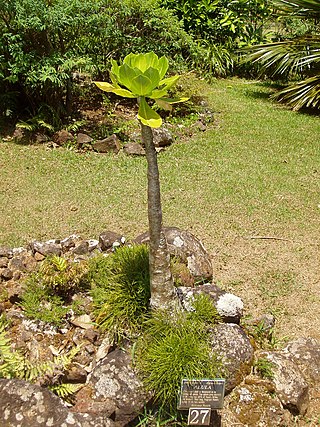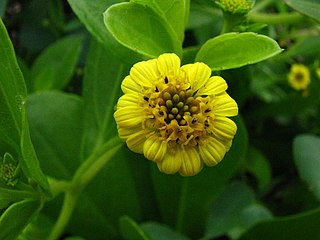
Ptelea trifoliata, commonly known as common hoptree, wafer ash, stinking ash, and skunk bush, is a species of flowering plant in the citrus family (Rutaceae). It is native to North America, where it is found in Canada, Mexico, and the United States. It is a deciduous shrub or tree, with alternate, trifoliate leaves.
Located about 2,300 miles (3,680 km) from the nearest continental shore, the Hawaiian Islands are the most isolated group of islands on the planet. The plant and animal life of the Hawaiian archipelago is the result of early, very infrequent colonizations of arriving species and the slow evolution of those species—in isolation from the rest of the world's flora and fauna—over a period of at least 5 million years. As a consequence, Hawai'i is home to a large number of endemic species. The radiation of species described by Charles Darwin in the Galapagos Islands which was critical to the formulation of his theory of evolution is far exceeded in the more isolated Hawaiian Islands.

Avicennia marina, commonly known as grey mangrove or white mangrove, is a species of mangrove tree classified in the plant family Acanthaceae. As with other mangroves, it occurs in the intertidal zones of estuarine areas.

Brighamia insignis, commonly known as ʻŌlulu or Alula in Hawaiian, or colloquially as the vulcan palm or cabbage on a stick, is a species of Hawaiian lobelioid in the bellflower family, Campanulaceae. It is native to the islands of Kauaʻi and Niʻihau, but has been extinct in the wild since at least 2019-2020. This short-lived perennial species is a member of a unique endemic Hawaiian genus with only one other species.

Lipochaeta succulenta, the seaside nehe, is a plant endemic to all the main Hawaiian islands except Lanai.

Hibiscadelphus distans is an extremely rare species of flowering plant in the mallow family, Malvaceae, that is endemic to the island of Kauaʻi in Hawaii. It is known as hau kuahiwi in Hawaiian, which means "upland Hibiscus tiliaceus." It is a bush or small tree with heart-shaped leaves and yellow flowers and grows at between 1,000 and 1,800 feet in the remnants of native dry forests. Despite its rarity, it is believed to be the only surviving species in the genus Hibiscadelphus which is only known from Hawaii, the other five species having recently become extinct in the wild, some being known from only a single plant.
Hibiscadelphus woodii, or Wood's hau kuahiwi, is a species of flowering plant in the family Malvaceae endemic to Kauai, Hawaii.
Kokia kauaiensis, the Kauai treecotton or Kauaʻi Kokiʻo, is a species of flowering plant in the mallow family, Malvaceae, that is endemic to Kauaʻi, Hawaii.

Schiedea adamantis, commonly known as Diamond Head schiedea, is a species of flowering plant in the family Caryophyllaceae, that is endemic to the island of Oʻahu in Hawaii. It inhabits low shrublands on steep slopes along the northwest rim of Diamond Head Crater. Associated plants include nehe, kāwelu, ʻakoko, and ʻilima. There are only about 30 individuals remaining, and they are threatened by habitat loss.

Lipochaeta, common name nehe, is a genus of flowering plants in the family Asteraceae that is endemic to Hawaii.

Melanthera, is a genus of perennial flowering plants in the family Asteraceae, native to the tropical and subtropical Americas.
Cyanea dolichopoda was a species of shrub in the bellflower family that was endemic to Kauai. It was discovered in 1990 and has not been located in the wild since 1992. Like other Cyanea it is known as haha in Hawaiian.

Gouania meyenii is a rare species of flowering plant known by the common name smoothfruit chewstick or Meyen's gouania. It is endemic to Hawaii, where it is known only from Oahu and Kauai. It is estimated that there are between 38 and 63 individuals of this species remaining in the wild. It is a federally listed endangered species of the United States.

Lipochaeta fauriei known by the common name Olokele Canyon nehe, is a rare species of flowering plant in the aster family.
Lipochaeta kamolensis known by the common name Maui nehe, is a rare species of flowering plant in the family Asteraceae.

Lipochaeta tenuifolia is a rare species of flowering plant in the family Asteraceae known by the common names Waianae Range nehe and slender-leaf nehe.
Lipochaeta venosa is a rare species of flowering plant in the family Asteraceae known by the common name spreading nehe. It is endemic to Hawaii, where it is known only from the island of Hawaii. It is federally listed as an endangered species of the United States.
Lipochaeta waimeaensis is a rare species of flowering plant in the family Asteraceae known by the common name Waimea Canyon nehe. It is endemic to Hawaii, where it is known only from the island of Kauai. It is federally listed as an endangered species of the United States.
Schiedea attenuata is a rare species of flowering plant in the family Caryophyllaceae known by the common name Kalalau schiedea. It is endemic to Hawaii, where it is known only from the Kalalau Valley on the island of Kauai. It is threatened by the degradation of its habitat. It was federally listed as an endangered species of the United States in 2010.

Kunzea micrantha is a flowering plant in the myrtle family, Myrtaceae and is endemic to the south west of Western Australia. It blooms between September and December producing pink-purple to white-cream flowers. A widespread and variable species, it is difficult to distinguish from K. praestans and from K. micromera where their range overlap.

















